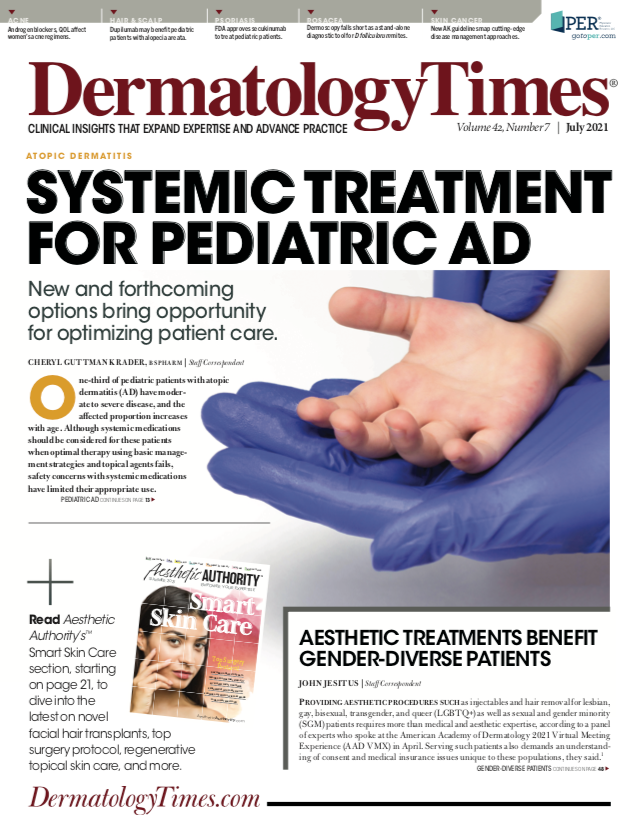- Case-Based Roundtable
- General Dermatology
- Eczema
- Chronic Hand Eczema
- Alopecia
- Aesthetics
- Vitiligo
- COVID-19
- Actinic Keratosis
- Precision Medicine and Biologics
- Rare Disease
- Wound Care
- Rosacea
- Psoriasis
- Psoriatic Arthritis
- Atopic Dermatitis
- Melasma
- NP and PA
- Skin Cancer
- Hidradenitis Suppurativa
- Drug Watch
- Pigmentary Disorders
- Acne
- Pediatric Dermatology
- Practice Management
- Prurigo Nodularis
- Buy-and-Bill
Publication
Article
Dermatology Times
Examining Eyebrows
Author(s):
In this month's Cosmetic Conundrums column, Dermatology Times® Chief Medical Editor Zoe Diana Draelos, MD, explores the world of eyebrows, including microblading, grooming, and shape.
Q: Is microblading of the eyebrows safe?
Microblading has become very popular for females with thinning eyebrows and males who also desire increased eyebrow thickness. Microblading is basically a superficial eyebrow area tattoo. The tattoo ink color is selected and blended to match the hair color of the female and then small cuts are made in the eyebrow area to mimic hairs. The pigment is pushed into the cuts to create a semipermanent tattoo. Microblading is designed to last 1 to 3 years, but most women require a yearly touch-up. Some of the tattoo ink is removed with scabbing that follows the procedure, which may necessitate a touch-up shortly after the initial procedure. With time, additional tattoo ink will become phagocytized by white blood cells and transported to lymph nodes, accounting for pigment fading.
It is critical that no water contact the freshly microbladed area for 1 week. This is because washing and water can remove the pigment that was superficially deposited in the skin until healing occurs. Once the skin has healed, the pigment is trapped in the skin. Avoiding water contact includes not only washing but also sweating and swimming.
Microblading has largely replaced eyebrow tattooing because the small cuts resemble hairs better than a solid tattooed line. Microblading is also not permanent, allowing for changes in the eyebrow architecture with aging. Loss of subcutaneous fat on the forehead results in lowering of the eyebrows and loss of the natural eyebrow arch. Semipermanent microblading allows for the adjustment of eyebrow contour with aging. Many postmenopausal women notice loss of the lateral third of the eyebrow with estrogen deficiency. This loss removes the very feminine eyebrow curve, creating a more flattened eyebrow appearance characteristic of male facial architecture. Microblading can recreate the lateral eyebrow in an artistic manner in the hands of an excellent technician.
The biggest challenge to microblading is finding a skilled technician who has the same vision of the patient’s eyebrows as the patient. I recommend patients take a younger picture of themselves to the salon to show the technician how to recreate the desired eyebrow. It is best to recreate the youthful eyebrow of the patient rather than to try to create eyebrows randomly selected by the patient from a magazine picture. Even though microblading is not permanent, the patient will be saddled with a poor result for at least a year. Asking around about friends’ experiences and getting recommendations from others who have undergone the procedure is the best way to ensure an attractive result. Microblading costs between $500 and $1200, depending on the location and reputation of the salon.
Q: What is the safest way to groom unruly eyebrows?
One of the reasons mature women undergo microblading is because eyebrow growth no longer occurs due to overplucking. If a woman heavily plucks her eyebrows to achieve the Greta Garbo look, eventually traumatic plucking will result in failure of the eyebrow hairs to grow. Most eyebrow hair removal methods involve some type of potential trauma to the hair follicle. Threading, waxing, and tweezing all yank the hair from the follicle. Gentle removal of unwanted eyebrow hairs is very important. Using a good pair of tweezers and exerting firm, steady pressure until the hair is epilated is important. Do not yank or aggressively pull the hair. Also, only pluck hairs that would never be acceptable in well-groomed eyebrows. Avoid the temptation to pluck eyebrows to meet current fashion standards.
It is hard for young female patients to imagine a day when their eyebrows will not grow; however, this day will come even for those with bushy eyebrows. Moderation in plucking is important. Tell female patients to only pluck those hairs that they would never want to regrow at any time in their life.
Q: How should eyebrows be shaped?
There are many different opinions on the optimal female eyebrow. Basically, eyebrows should be shaped by the female patient to frame the eye in the most attractive manner possible. I generally give patients who desire eyebrow assistance, either for too much or too little growth, the following 3 points. I tell them to get a pen to use as a straight line for identification of facial landmarks.
- The eyebrow should start at a point defined by a line drawn from the corner of the nose to the inner canthus.
- The eyebrow should arch at a point defined by a line drawn from the corner of the nose to the midpupil.
- The eyebrow should end at a point defined by a line drawn from the corner of the nose to the lateral canthus.
Eyebrows that follow these ideal proportions, laid out originally by the ancient Greeks, are appropriate for all sizes and ethnicities of female faces. In contrast, the male face is characterized by a flattened eyebrow without the female arch.






